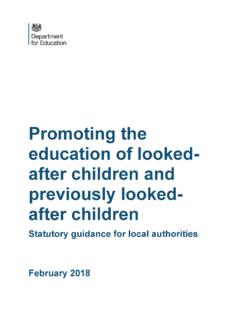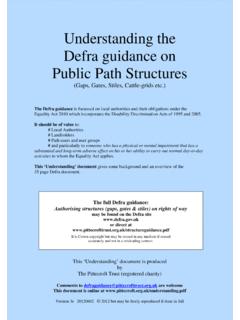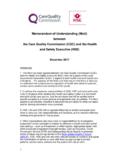Transcription of Promoting the health and well-being of looked-after children
1 Promoting the health and well-being of looked-after children Statutory guidance for local authorities , clinical commissioning groups and NHS England March 2015. Contents Summary 4. About this guidance 4. Terms used in this guidance 4. How to use this guidance 5. Expiry or review date 5. What legislation does this guidance refer to? 5. Who is this guidance for? 5. Main points 6. Supporting all looked-after children : joint responsibilities 8. Context 8. Overarching principles 8. Planning health services for looked-after children 9. Commissioning health services 11.
2 The responsible commissioner 12. The role of the designated doctor and nurse 13. Planning and providing services to promote the health of individual looked-after children 14. The care planning framework 14. Notification of placement 14. Information sharing 14. health assessments, plans and reviews 15. Mental health services 19. Special educational needs (SEN) 19. The role of social workers in Promoting health 20. The roles of Virtual School Heads (VSHs) and designated teachers 21. The role of Independent Reviewing Officers (IROs) 21. The contribution of primary care teams 21.
3 health professionals and the role of named health professionals for looked-after children 22. Placement out of authority 23. Supporting foster carers and children 's homes to promote health 24. children detained under the Mental health Act or in custody 25. 2. Transitions from care 25. Annex A: Age-appropriate health assessments 28. Recommended content 28. Annex B: Strengths and Difficulties Questionnaire (SDQ) 30. Annex C: Principles of confidentiality and consent 32. children aged 16 and 17 33. children aged 15 and under 33. Annex D: Some terms used in this guidance 34.
4 Further information 36. Useful resources and external organisations 36. Other relevant departmental advice and statutory guidance 36. 3. Summary About this guidance This is joint statutory guidance from the Department for Education and the Department of health . It is for local authorities , clinical commissioning groups (CCGs) and NHS. England and applies to England only. This guidance is issued to local authorities , CCGs and NHS England under sections 10. and 11 of the children Act 2004 and they must have regard to it when exercising their functions. It is also issued under section 7 of the local Authority Social Services Act 1970.
5 This requires local authorities in exercising their social services functions to act under the general guidance of the Secretary of State. local authorities must comply with this guidance unless there are exceptional reasons that justify a departure. This guidance replaces the Statutory guidance on Promoting the health and well-being of Looked After children , which was issued in November 2009 to local authorities , Primary Care Trusts and Strategic health authorities . The guidance published in 2009. has been updated to reflect reforms to the National health Service following the health and Social Care Act 2012.
6 It also takes account of other reforms such as changes to the special educational needs legislative framework and the cross-Government mental health strategy, which emphasises that mental health is as important as physical health . This guidance should be read in conjunction with: The children Act 1989 guidance and Regulations Volume 2: Care Planning, Placement and Case Review The children Act 1989 guidance and Regulations Volume 3: Transition to Adulthood The children Act 1989 guidance and Regulations Volume 4: Fostering Services Guide to the children 's Homes Regulations, including the Quality Standards Statutory guidance on Joint Strategic Needs Assessments and Joint health and Wellbeing Strategies Who Pays?
7 Determining responsibility for payments to providers National Tariff Payment System Terms used in this guidance There is a glossary of technical terms used in this guidance . This can be found at Annex D. 4. How to use this guidance The main points summarise the high level information local authorities , CCGs and NHS. England need to know. More details about each point and further guidance are set out in the rest of this document. Expiry or review date This guidance will be reviewed in 2020 or sooner if deemed to be necessary. What legislation does this guidance refer to?
8 The children Act 1989 and associated regulations 1. The children Act 2004. The Mental Capacity Act 2005 Deprivation of Liberty Safeguards The National health Service Act 2006. The Mental health Act 2007. The health and Social Care Act 2012. The Care Act 2014. The children and Families Act 2014. Who is this guidance for? This guidance is for: all local authority managers and staff who have responsibilities for looked-after children , including Directors of Public health , commissioners of placements, and staff who support and supervise carers commissioners of health services for children NHS England designated and named professionals for looked-after children GPs, optometrists, dentists and pharmacists Lead Members for children 's Services in local authorities managers and staff of services for care leavers, and Personal Advisers teachers health visitors.
9 School nurses and any other professional who is involved in the delivery of services and care to looked-after children . 1. The Care Planning, Placement and Case Review (England) Regulations 2010. 5. Main points The corporate parenting responsibilities of local authorities include having a duty under section 22(3)(a) of the children Act 1989 to safeguard and promote the welfare of the children they look after, including eligible children and those placed for adoption, regardless of whether they are placed in or out of authority or the type of placement. This includes the promotion of the child's physical, emotional and mental health and acting on any early signs of health issues.
10 The local authority that looks after the child must arrange for them to have a health assessment as required by The Care Planning, Placement and Case Review (England) Regulations 2010. The initial health assessment must be done by a registered medical practitioner. Review health assessments may be carried out by a registered nurse or registered midwife. The local authority that looks after the child must ensure that every child it looks after has an up-to-date individual health plan, the development of which should be based on the written report of the health assessment.


















